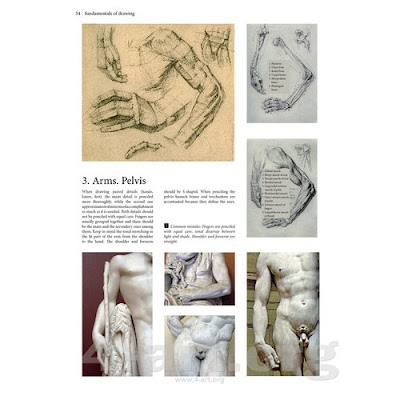Recently, I had the opportunity to read a magnificent book on drawing.
"Fundamentals of Drawing" by V.A. Mogilevtsev, is used in Russia as a text and is recommended as a reference standard by the St. Petersburg State University. The original was published a decade or so ago in Russian and quickly became the standard; the first English edition was printed in 2016.
This book is systematic clear, providing step by step instruction with progressive drawings and detailing the thinking behind each. This seems to be the defining process in much of the Russian realist tradition. One section is devoted to the head, the other to the figure. Although the book is relatively short, the large format and systematic organization provide considerably more content than one would expect in just over 70 pages.
Particularly attractive is the layout of the pages. Each step is illustrated by images of steps in the drawing on the right-hand page and commentary on the left. This provides full page (or nearly) images that are superbly reproduced.
 |
| Construction of the hand and arm (left-hand page) |
Prof. Mogilevtsev emphasizes in the beginning that concept must rule every decision. You cannot begin a work without a clear idea to convey to the viewer. The approach reminds me very much of that advocated by illustrators of the 20th century: most of the work involved making the picture goes into creating an effective concept to convey what must be said. Norman Rockwell was an exemplar of that approach, often going through dozens of thumbnail sketches while working on a problem. Furthermore, this author emphasizes that one cannot begin a work without recognizing that the medium itself is at least
part of the message as well. The choice of materials should fit the concept and the solution of how to convey an emotion, idea, or thought. If concept is not sound, the artist can't (well, shouldn't) proceed.
Beyond concept there are four more steps in this system: 2) Rough drawing, 3) Construction based on rough drawing, 4) Defining Details, and 5) Final step. Further, the system divides each of these into sub-steps on the way to finish. It's clear that following the system and working on examples is likely to provide substantial growth to the dedicated student. Further, besides the two sections on the head and on the figure, a third section provides examples from classical and other eras for study and copying.
 |
| Full page spread showing progress drawing (r) and examples (l) |
This is a wonderful and very clear way to move forward in learning to draw. Once one has developed fundamental drawing skills with various media--graphite, charcoal, ink, and probably digital--this system will provide a useful structure to hang them on. Highly recommended.
---
Previous Posts in this series:
Favorite Art Books Part 9
Favorite Art Books Part 8
Favorite Art Books Part 7
Favorite Art Books Part 6
Favorite Art Books Part 5
Favorite Art Books Part 4
Favorite Art Books Part 3
Favorite Art Books Part 2
Favorite Art Books Part 1



No comments:
Post a Comment